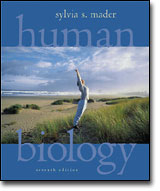|
 |  Human Biology, 7/e Dr. Sylvia S. Mader
Digestive System and Nutrition
Chapter Outline
5.1 The Digestive SystemThe human digestive system is an extended tube with specialized parts between two openings, the mouth and the anus. 82
Food is ingested and then digested to small molecules that are absorbed. Indigestible materials are eliminated. 82 |
 |  |  | 5.2 Three Accessory OrgansThe pancreas, the liver, and the gallbladder are accessory organs of digestion because their activities assist the digestive process. 90 |
 |  |  | 5.3 Digestive EnzymesThe products of digestion are small molecules, such as amino acids, fatty acids, and glucose, that can cross plasma membranes. 92
The digestive enzymes are specific and have an optimum temperature and pH at which they function. 92 |
 |  |  | 5.4 HomeostasisThe digestive system works with the other systems of the body to maintain homeostasis. 95 s |
 |  |  | 5.5 NutritionProper nutrition supplies the body with energy, nutrients, and all vitamins and minerals. 95 |
|
|



 2002 McGraw-Hill Higher Education
2002 McGraw-Hill Higher Education